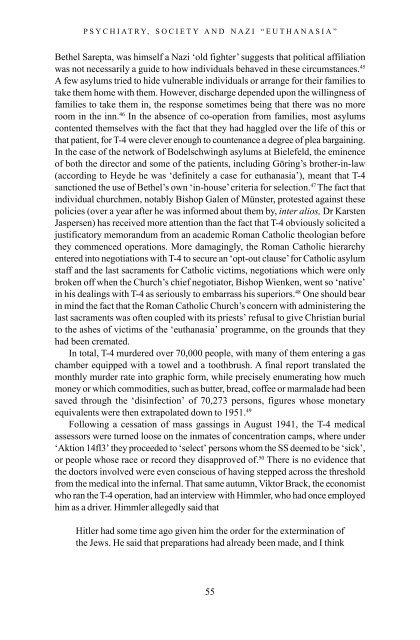The_Holokaust_-_origins,_implementation,_aftermath
The_Holokaust_-_origins,_implementation,_aftermath
The_Holokaust_-_origins,_implementation,_aftermath
You also want an ePaper? Increase the reach of your titles
YUMPU automatically turns print PDFs into web optimized ePapers that Google loves.
PSYCHIATRY, SOCIETY AND NAZI “EUTHANASIA”<br />
Bethel Sarepta, was himself a Nazi ‘old fighter’ suggests that political affiliation<br />
was not necessarily a guide to how individuals behaved in these circumstances. 45<br />
A few asylums tried to hide vulnerable individuals or arrange for their families to<br />
take them home with them. However, discharge depended upon the willingness of<br />
families to take them in, the response sometimes being that there was no more<br />
room in the inn. 46 In the absence of co-operation from families, most asylums<br />
contented themselves with the fact that they had haggled over the life of this or<br />
that patient, for T-4 were clever enough to countenance a degree of plea bargaining.<br />
In the case of the network of Bodelschwingh asylums at Bielefeld, the eminence<br />
of both the director and some of the patients, including Göring’s brother-in-law<br />
(according to Heyde he was ‘definitely a case for euthanasia’), meant that T-4<br />
sanctioned the use of Bethel’s own ‘in-house’ criteria for selection. 47 <strong>The</strong> fact that<br />
individual churchmen, notably Bishop Galen of Münster, protested against these<br />
policies (over a year after he was informed about them by, inter alios, Dr Karsten<br />
Jaspersen) has received more attention than the fact that T-4 obviously solicited a<br />
justificatory memorandum from an academic Roman Catholic theologian before<br />
they commenced operations. More damagingly, the Roman Catholic hierarchy<br />
entered into negotiations with T-4 to secure an ‘opt-out clause’ for Catholic asylum<br />
staff and the last sacraments for Catholic victims, negotiations which were only<br />
broken off when the Church’s chief negotiator, Bishop Wienken, went so ‘native’<br />
in his dealings with T-4 as seriously to embarrass his superiors. 48 One should bear<br />
in mind the fact that the Roman Catholic Church’s concern with administering the<br />
last sacraments was often coupled with its priests’ refusal to give Christian burial<br />
to the ashes of victims of the ‘euthanasia’ programme, on the grounds that they<br />
had been cremated.<br />
In total, T-4 murdered over 70,000 people, with many of them entering a gas<br />
chamber equipped with a towel and a toothbrush. A final report translated the<br />
monthly murder rate into graphic form, while precisely enumerating how much<br />
money or which commodities, such as butter, bread, coffee or marmalade had been<br />
saved through the ‘disinfection’ of 70,273 persons, figures whose monetary<br />
equivalents were then extrapolated down to 1951. 49<br />
Following a cessation of mass gassings in August 1941, the T-4 medical<br />
assessors were turned loose on the inmates of concentration camps, where under<br />
‘Aktion 14fl3’ they proceeded to ‘select’ persons whom the SS deemed to be ‘sick’,<br />
or people whose race or record they disapproved of. 50 <strong>The</strong>re is no evidence that<br />
the doctors involved were even conscious of having stepped across the threshold<br />
from the medical into the infernal. That same autumn, Viktor Brack, the economist<br />
who ran the T-4 operation, had an interview with Himmler, who had once employed<br />
him as a driver. Himmler allegedly said that<br />
Hitler had some time ago given him the order for the extermination of<br />
the Jews. He said that preparations had already been made, and I think<br />
55



